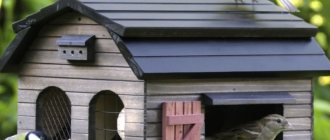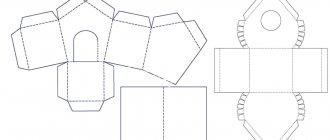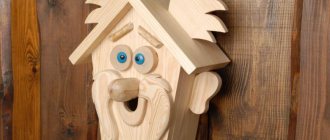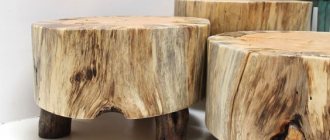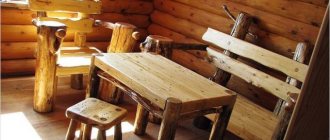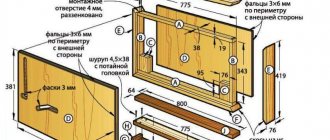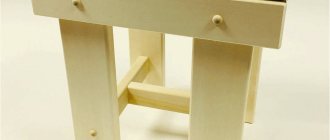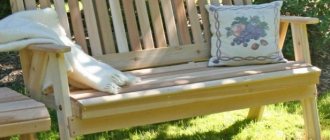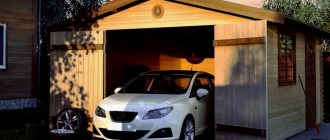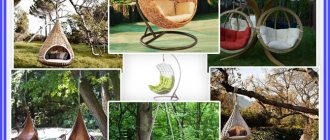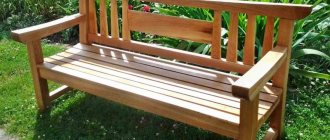A birdhouse is a type of artificial closed nesting box, the most popular both among people - friends of wild birds, and among their charges. The tradition of hanging birdhouses on Bird Day exists all over the world, and here and there real birdhouse towns appear in places suitable for nesting, see fig.
Birdhouse towns
Note: International Bird Day, April 1, is not celebrated in the Russian Federation. In Russia it is customary to consider the so-called Bird Day. Finding, but not a Christian church holiday, but a folk one. The People's Obretenie falls on March 9 according to the Gregorian calendar; this date is more suitable for hanging birdhouses, see below. The origin of the name of the people's Finding is connected not with the finding of the head of John the Baptist, but with beekeeping - if by this day the bees are found (are) in the hives, then it means they have wintered safely.
Making a good birdhouse with your own hands is not difficult; Even a schoolboy can cope with this. Birdhouses are used to attract not only insect-killing birds to household plots and summer cottages, but also small songbirds to cities and homes, as well as to create nesting sites for hollow-nesting birds in forests and parks. Many useful and beautiful birds nest in hollows and competition for “living space” during the nesting season is fierce, because There are not so many hollows in the trees and, as a rule, they have been occupied by someone since the fall.
The technology for assembling a birdhouse is really simple; it does not require expensive and/or complex processing materials. But to make a birdhouse, you need to know in advance who will live in it. In closed nesting areas, many small birds, otherwise capable of nesting openly, do not mind building a nest. All potential birdhouse new settlers have their own nesting requirements, so the designs of birdhouses for different species or groups of bird species differ, as reflected in their names: titmouse, flycatcher, wagtail, owlcatcher, etc.
General terms
The structure of a birdhouse in general is as follows: it is an elongated upward cavity, mainly in wood, with a solid bottom and a removable lid. Under the roof there is a hole - an entrance - for the birds that have settled in it. A removable lid is necessary, firstly, for autumn inspection and cleaning of the cavity: of the birds, only starlings, tits and nuthatches, after the chicks have fledged, they certainly throw away the old nesting material and do “general cleaning”. Most of the others leave the garbage as is and next year the cluttered “recycling” will no longer occupy it. Secondly, instead of birds, the birdhouse may be taken over by unwanted animal occupiers; We'll talk about them below.
The body (structure) of the birdhouse can be assembled from boards, as well as some other materials, or hollowed out or chopped from a piece of log - churak; the latter are called nest boxes. The dimensions of the birdhouse are usually, depending on the type of birds for which it is intended, 20-40 cm in height; a tap hole with a diameter of 2.5-6 cm is located 5-6 cm under the roof. The extension of the roof above the entrance should be at least 5 cm for protection from rain and cats. The diameter of the internal cavity (nesting chamber) ranges from 10x10 to 15x19 cm in birdhouses made of boards or with a diameter of 7 to 20 cm in nest boxes. Sometimes a pole or landing platform for parents is required in front of the entrance; in what cases - let's look further.
Houses like birdhouses are also made for other animals living in hollows: squirrels, bats, but their proportions are different. Making a birdhouse for birds within the specified height limits is necessary so that the chicks can still climb the walls to feed, but for squirrels, and especially dormouse, such a high threshold would be inconvenient. You should not make the nesting chamber too spacious, firstly, for the same reason. Secondly, in a large nesting area, the female will lay more eggs, but the parents will not have enough strength to feed them all. Some chicks will then die, and the remaining ones will grow stunted and will not survive the winter.
Instructions
Having studied the sizes for birds, and having prepared all the necessary materials and tools for a birdhouse made of wood with your own hands, you can safely proceed to the next steps, namely making a house.
- Mark the boards with a pencil and tape measure.
- Use a hacksaw to cut the resulting boards.
Important! The roof should extend beyond the base of the birdhouse to prevent precipitation from getting inside.
- Use a drill or jigsaw to cut a hole (entrance for birds).
- Outside (at the joints) it is necessary to drive nails.
- Place a bird perch under the hole.
After making sure that all the parts are present, you can begin to fully assemble the house.
What are the birds waiting for?
A bird house must meet very specific requirements. First, it must be strong and opaque: the secrecy of the brood is the main reason why hollow nesters nest in tree cavities. Further, the inner walls should not be very hard and slightly rough, so that the chicks can climb towards their parents who have flown in with food. Without this physical exercise, the chicks will not get up on their wings properly and will not be able to withstand the flight to wintering grounds or will become victims of predators.
The following conditions: the material of the birdhouse should be moderately sound-permeable, retain heat as best as possible, and its structure should not have any cracks. Reasons: the chicks must hear their arriving parents or a creeping predator, but at the same time their squeaks should not spread far. In addition, the chicks of all hollow nesters are naked at first, the slightest draft can destroy them, and getting the nest wet will certainly destroy the entire brood. Chicks, like all birds, emit quite a lot of heat, and in an insulated, dry home they will have a much better chance of surviving a sudden cold snap.
About materials
It is best to make a birdhouse Only seasoned conifers are suitable, without visible streaks or a noticeable smell of resin. The best ones are used, from some dismantled shed. The thickness of the boards is 20-30 mm, then the conditions of sound conductivity and thermal insulation will be met. If the boards are planed, then the inner side of the one where the tap hole will be needs to be “roughened”: treated with coarse sandpaper, covered with notches or scratches with the tip of a knife or the corner of a chisel.
Note: in some cases, some other materials are suitable or even preferred, incl. and discarded henchmen. We will talk about their use further.
Plywood, even waterproof plywood, is not suitable for birdhouses: it muffles sounds and does little to prevent heat loss. OSB, chipboard, fiberboard are absolutely unsuitable - birds are much more sensitive than us to the vapors of phenol compounds. The nesting chamber made of artificial lumber on a phenolic binder of the highest consumer class for chicks will turn into a gas chamber. MDF, which does not contain phenolic resins, would in principle be suitable, but this is a material for internal use and will soon swell and become limp under the influence of precipitation.
Enemies and defense
There are plenty of people in nature who want to feast on eggs or chicks. In addition, the birdhouse can be occupied by new residents “without a warrant,” or even extremely undesirable ones in the garden, such as, for example. Sonya Dormouse is interested in the seeds in juicy fruits, and just a couple of these animals can spoil the harvest of the entire garden. The birdhouse can also be captured by squirrels, bats, and in Siberia, chipmunks. In general, there is no harm from four-legged invaders, but beneficial birds are deprived of nesting sites.
The worst destroyers of birdhouses are large woodpeckers, great spotted woodpeckers and woodpeckers. By the beginning of nesting time, these generally useful birds experience an acute shortage of animal protein; it is time for them to nest, too, and for this, woodpeckers peck at birdhouses, destroying eggs and chicks. There is nothing to be done, everything is poison and everything is medicine, not only in medicine.
In second place in terms of danger to the brood are cats, domestic and wild. Small predators from the mustelidae family, strange as it may seem at first glance, do not pose a particular danger to the clutches and chicks: by the time the birds nest, they have abundant, easily accessible prey at their disposal - mice, voles.
Protecting birdhouses from destruction
Methods for protecting a birdhouse from destruction are shown in Fig. Pos. 1 – from woodpeckers: a tin collar 5-6 cm wide, upholstered with small nails at the same distance or an overlay made of straight-grained wood with fibers oriented horizontally; the fact is that woodpeckers can only peck at wood with vertical grains. The latter method is preferable, because The cover does not rust and does not create inconvenience for the owners of the house. But keep in mind that the rest of the structure must be made of wood with fibers oriented vertically or obliquely, otherwise the bird’s house will quickly split.
Pos. 2 – protection from cats. The best way is an anti-cat “skirt”; it can be made from dry branches or pieces of wire. 1-2 short twigs at the root part are cut so that small inclined stumps remain, and the entire belt is fastened with wire passing under them, without pulling it tightly so as not to damage the tree. The “skirt” is placed at the same height as the lower tin belt, see below.
The threshold inside under the entrance (below in position 2) is less labor-intensive, but inconvenient for both the chicks and their parents. It is done if it is not possible to arrange an anti-cat belt. Another good remedy for cats is a wooden collar protruding outward by 3-5 cm around the entrance.
Method for pos. 3 – tin belts – provides a complete guarantee against both predators and occupiers. Indicated in Fig. dimensions, in cm, must be maintained with an accuracy of 3-4 cm; they are designed so that potential destroyers cannot jump over the belts, then catching on the bark, either from below or from above. Of course, in the section of the trunk between the belts there should be no branches, twigs, feeders or other supports for predators.
Note: a good method only from occupiers is hanging in the fall, before the cold weather, the so-called. temporary replacement birdhouses. We will talk about them further.
For starlings
Common starlings are the most common and most desirable inhabitants of birdhouses. Therefore, without going into details for now, let’s see how to make a birdhouse for starlings. The common starling is a rather large bird for hollow nesters, and its relatives, the mynah starling and others, are even larger. Therefore, in general, a birdhouse, which is a birdhouse, is larger and deeper than others, its entrance is wider, and a pole is required under the entrance. Starlings prefer to nest in places inaccessible to predators, but with good visibility, and the starling is a very caring head of the family. He will sing a marriage song only if the chosen one has the opportunity to immediately inspect and accept the living space attached to the proposal of the wing and heart.
Drawings of a birdhouse for starlings
Drawing of the most popular birdhouse, the so-called. village type is shown in Fig. The assembly order is as follows:
- Blanks are cut from the board;
- In the facade, a taphole is cut out in advance using a feather drill or a wood crown, a pole is inserted into the drilled hole, the inside of the front wall, if necessary, is “roughened” as indicated above;
- The sides are glued to the bottom and then the front and back walls;
- Level the box from the bottom and side walls while the glue is liquid, and tie it with twine until it sets;
- Dry the box in a vertical position on a spread polyethylene film;
- When the glue has set, the box is fastened with nails or self-tapping screws, 2-3 for each glue seam;
- Trying on the blank of the lid without the lining, trim/trim the upper edges of the front and rear walls so that the roof fits tightly;
- The lid overlay is placed on flowing glue, the lid is put in place, and supporting the overlay with a finger through the tap hole, the roof is finally adjusted in place;
- Once the glue under the lining has set, pull it to the lid with 4 small nails or self-tapping screws.
These instructions for making a birdhouse are designed to use PVA glue. In old manuals, from which current authors copy a lot of really useful advice, they recommend assembling birdhouses using wood glue, but this is because much better PVA simply wasn’t available then. Compared to PVA bone wood glue:
- Water resistant.
- It is plastic when dried: it does not dry out, does not crack, and ensures complete sealing of the seams.
- Allows you to smear the parts with glue and immediately fold them, within 3-5 minutes to adjust the connection in place, slightly moving the parts in passing, without breaking the adhesive layer.
- Always ready to work, does not require the use of a glue gun or other special equipment.
- Used as an impregnating composition diluted 3-5 times with water, it allows the use of some waste hygroscopic materials for birdhouses.
- Cheaper than wood glue and more durable outdoors.
PVA has only 2 disadvantages over wood glue: its seam is plastic, which is not significant for a birdhouse that is not a sideboard or a sofa, and after assembling it on PVA, the product must be dried for at least a day in a warm room, and wood glue sets immediately.
Drawings with dimensions
Some drawings of birdhouses are in the text, we are posting a few more in this section. Adjusting the dimensions to suit the planned “tenants” is probably not a problem. Also note that the layout is given for a 2 cm thick board. Adjustments are necessary when increasing or decreasing the thickness.
Birdhouse with a triangular roof: drawing, dimensions
Birdhouse with a triangular roof: breakdown of parts
Birdhouse with a sloping roof (the front wall is higher). Hole diameter - 45-50 mm
When and how to hang?
Well, let's assume that the birdhouse is ready. When and how to hang it? There are 2 seasons for hanging birdhouses: in the fall, after the harvest, but before the cold weather, birdhouses for wintering birds are hung: titmice, nest boxes for nuthatches and substitute birdhouses for occupiers. Birdhouses for migratory birds, incl. starlings are hung in the spring, a week and a half before the start of the birds' mating games.
If you are familiar with ornithology, then you need to hang bird houses, especially for certain types of birds (see below), after noticing the harbinger birds. They arrive in advance at their summering grounds, hang around there for several days, hardly feeding, and then fly away. There are always few harbingers, they examine the area, “report” to their relatives and, if everything is in order, a mass arrival begins. The points of the “report” also include the nesting situation; if the harbingers were seen as “fresh”, i.e. obviously not competitive and not looked after by nest destroyers, they will not fail to notify their brothers about this in their own way, and the settlement of the “new buildings” is ensured.
If you have no experience in bird watching, nesting sites should be erected in the central zone of the Russian Federation during March, but before the April heat hits. Here you can roughly navigate by the first thawed patches: when the tubercles on them “wither,” you need to hang them. Somewhat more precisely - according to the weather, when the equinox storms will pass; as meteorologists say, when latitudinal movements of atmospheric masses in the temperate zone prevail over meridional ones, but in places with a continental climate this sign is weakly expressed.
It would not be a mistake to hang birdhouses on National Bird Day (March 9) or on the first Sunday after it, but in this case there is a fairly high probability that they will be occupied and the harbingers will overlook them. However, you can insure against the first one by hanging substitutes in the fall.
The second question is how to hang a birdhouse correctly? General rules:
- The entrance should be oriented east-southeast so that in the spring the first rays of the Sun penetrate into it.
- Suspension height 3-5 m.
- It is preferable to hang it on trees, it seems safer for the birds.
- An exception is wagtails (see below), they need to be hung under the roof of a barn (not a residential building!) at the same height.
- The titmouse can be hung on the wall of the house, balcony or under the ceiling of the veranda if the birds were regularly fed nearby during the winter.
- A birdhouse for starlings can be raised on a pole in a bare yard.
- If the birds were fed in winter, the birdhouse should be no closer than 15-20 m from the feeder, so as not to attract the attention of destroyers.
A rather serious sub-question - how to attach a birdhouse to a support? Nailing it with nails opens the way for diseases and pests into the tree, and the benefits of birds may go in vain. In addition, cats know how to slowly tear off nailed birdhouses or, throwing off the roof, grab chicks.
How to hang birdhouses
The main methods of hanging birdhouses and errors in doing so are shown in Fig. According to pos. 1 bird house is attached if there is no thick enough wood. Method according to pos. 2 – optimal, it does not harm the tree at all, and the birdhouse holds firmly. According to pos. 3 birdhouses are attached to a pole. Please note: ultimately, the birdhouse should be tilted down by 2-3 degrees; this will completely protect it from cats and make it easier for the chicks to get to feeding.
At pos. 4 – incorrect, pseudo-ecological method of hanging using wire and a wooden block; in fact, it harms the trees worse than nails, the log soon falls out, the birdhouse begins to wobble. And finally, when hanging on a tree, protection from cats is necessary, pos. 5.
How to climb a tree?
Birdhouses are also hung in the forest, and even in your own home, a ladder will not always help you climb a tree if it is spreading. That is, to hang a birdhouse, you will have to climb a tree. The first thing to remember here is don’t climb like children, clinging to branches. They may be racing against squirrels or monkeys, but you are twice or three times heavier, and if you fall from the same height, the impact will be about five times stronger, children’s bones are more elastic, and their internal organs are more resistant to deformation than those of adults.
The art of tree climbing is called arborism, and those who are interested in it are called arborists. Arborists climb trees using a safety belt and special devices - gaffs, which are, in essence, the same monter's claws. You can see the technique of lifting on gaffs in the video:
Video: how to climb trees?
And how to make gaffs yourself - from the video:
Video: homemade gaffs for climbing a tree
However, much less labor-intensive and, paradoxically, statistically safer is the method of lifting using a rope loop, which has long been used by tropical fruit pickers, see video:
Video: how to climb a tree without knots?
But in any case, as they say, the following precautions must be taken:
- Work only together, with an insurer below who knows how to provide first aid for bruises and fractures.
- Have transport on hand so that the victim can be quickly transported to a medical facility; everyone working must be able to manage it.
- Do not lift with a load; you need to attach a rope to your belt, and then, having established yourself in place, lift the birdhouse and, if necessary, a bag with tools on it.
- The insurer should not come closer than 3 m to the place of possible falling objects or the steeplejack, taking into account the strength and direction of the wind.
- The insurer must see the steeplejack at all times; when it disappears from sight, immediately command the descent, and the climber must unquestioningly carry out the command.
- And most importantly: before you start climbing, look out for yourself the path of descent and clearly understand the procedure for it.
Safety precautions
Working with wood requires following safety rules. When making even the simplest birdhouse, you can injure yourself with the tool or get a splinter in your finger. To prevent this from happening, remember the simple rules for carpentry and carpentry:
- It is advisable to wear comfortable and non-staining overalls and hide your hair under a beret. Thread or linen gloves are a must; they will protect you from splinters and significantly soften the blow if you or your young assistant are not yet very good with a hammer and often hit your fingers with a swing.
- If you have to do a lot of sawing and drilling, wear safety glasses to keep small sawdust out of your eyes.
- Tools such as a knife, hacksaw, saw, plane must be well sharpened.
It is very easy to injure yourself with a dull tool, since it is poorly fixed in the wood and constantly strives to slip.
- All power tools used in the work (screwdriver, drill, electric saw or jigsaw) must be in good working order and without damage. Do not allow moisture, chips, or other contaminants to come into contact with electrical appliances.
When finishing work or even taking a short break, unplug the tool from the power supply.
- When working, place cutting tools with the blade down.
You shouldn't cut material with it on your knee, even if you saw it in an interesting movie and it looked cool. In reality, such manipulations more often end in injuries rather than beautiful birdhouses.
- The hammer should be comfortable, with a suitable weight and a sufficiently long handle. Consider the tool in your hand, try driving a couple of nails with it, and if everything turned out easy and relaxed, you can continue working with it. Be sure to check that the working part is well secured to the handle.
- When hanging a finished birdhouse on a tree, be sure to use a ladder or stepladder. It’s very good if you do this not alone, but in the company of friends to protect each other.
Install a birdhouse as a group to protect each other
Sinichniki and special construction
With the help of a birdhouse you can attract many more useful, interesting and/or beautifully singing birds. But they are unlikely to settle in a nesting box, great. Artificial nesting boxes for small songbirds come in different types; Next we will figure out which of these birds need. First of all, we will consider stationary birdhouses made of wood, and after them, temporary substitutes made of other materials for wintering birds and distracting occupiers.
Note: special birdhouses are usually more difficult to make than regular ones. Therefore, before you get down to work, make sure that potential newcomers are part of the local avifauna, and be patient - except for tits, they do not trust humans as much as starlings. A “small-singing” birdhouse can hang for a year or two until it is occupied, and all this time you need to make sure that it does not become dilapidated, littered, or occupied by someone else.
Who else should we expect?
Desirable neighbors both in the city and on the plot will be, in addition to starlings and tits, great tits, tufted tits, blue tits, coal tits, long-tailed tits and chickadees (pos. 1-7 in the figure), also pikas, common and short-toed, or garden pikas (pos. 8 ; common and short-toed pikas are almost indistinguishable from a distance), nuthatches (5 species in the Russian Federation; in position 9 - common), gray flycatcher, position. 10, and pied flycatcher, pos. 11. All these birds (pos. 8-11) are cavity nesters, actively destroying harmful insects.
Birds inhabiting birdhouses
For redstarts (in pos. 12 there is a coot redstart; you can also expect black and red-bellied ones) and robins (pos. 13) any of the titmice described below is suitable. But the wagtail (pos. 14) requires a special “wagtail”, because The legs of this bird are not adapted for vertical climbing. You can build a birdhouse for wagtails by laying a school-type titmouse on its side, see below, and providing it with a kind of balcony, see fig. The “Wagtail” should either be installed in a bare yard on a pole 2.5-3 m high, reliably protected from cats, or hung under the eaves of a non-residential building for the same purpose. But the new settlers will not keep you waiting and, walking on the ground, will peck at many pests, and no one has yet noticed damage from wagtails anywhere.
Birdhouse for wagtails
If a great owl (pos. 15) is spotted nearby and you manage to attract it to the site, it’s a joy for the owner, but woe for the pests: this little owl is a living WMD for them. Small birds have nothing to fear from the pygmy owl: it was named so not because it is somehow dangerous to sparrows, but because it is the size of a sparrow. The pygmy owl, like the scops owl, can be tamed by feeding it with small pieces of raw meat and mealworms from time to time. He is friendly and his behavior is funny. But it will nest only in a nest box made of natural material (see below), and to make it requires considerable skill, as for any owl house.
Types and designs
I. Sokolovsky was involved in the design of birdhouses a lot. His developments served as the basis for many further designs. The design of 3 types of Sokolovsky birdhouses is shown in Fig; nest boxes will be discussed further.
Schemes of Sokolovsky's birdhouses
Titmouse
On the left in Fig. – diagram of a titmouse based on a typical birdhouse.
Designations, as for the next. pos:
- A – entrance diameter: 35 mm for great tit, tufted tit, blue tit, redstart and 30 mm for other tits and robins;
- B – side of a square bottom, 10 cm is enough. If the titmouse is intended only for great and tufted tits, common in the city, then it is better to take B = 12 cm;
- C – height of the front wall, 22 and 25 cm in the same order as in point 1;
- D – height of the back wall, 28 and 30 cm, respectively.
Note: the distance of the top of the entrance from the top of the front wall is 5 cm and the offset of the roof is from 5 cm, as for a regular birdhouse. A pole in front of the entrance is not needed.
Bird lovers, using Sokolovsky’s recommendations, try to create a titmouse birdhouse suitable for any small songbirds. Projects of 3 such titmice are presented in Fig. They differ, in essence, only in the roof structure. A school birdhouse is the easiest to make; no roof adjustment is required. These are exactly the kind that were made in Soviet schools during labor lessons; some students managed to make up to 3 items per lesson. A birdhouse-house provides better protection from cats and, especially, from precipitation. It is advisable to hang these in rainy places with a long spring. Flycatchers also nest in universal titmouses, but it is better to attract them with special birdhouses.
Universal birdhouse projects
Note: if you make the bottom of a universal birdhouse 15x15 cm (maximum for projects), then it will turn into a birdhouse primarily for starlings. Other birds will occupy it if there are not enough starlings to go around.
Half-loop and flycatcher
The gray flycatcher prefers to nest in semi-hollows, similar to natural voids in trees. The diagram of a half-nest birdhouse is shown in the center in Fig. with Sokolovsky's birdhouses. Dimensions:
- A – 4 cm;
- B – 10 cm (square);
- C – 7 cm;
- D – 14 cm.
Birdhouse for flycatchers
Pied flycatchers more readily occupy hollows in horizontal or slightly inclined thick branches, so they prefer a birdhouse-house in the form of a cubic nesting chamber with an inner side of about 12 cm, installed in a “diamond” pattern, i.e. downward angle, see fig. on right. The front wall needs to be made larger, about 20x20 cm, to protect it from cats. The diameter of the tap hole is 40 mm.
Flycatchers begin nesting relatively late, when there are enough insects. By that time, the heat has established itself, the parents provide the chicks with plenty of high-calorie food, so the thermal insulation of the flycatcher is no longer of decisive importance. This circumstance can be used to more fully imitate the nesting habitat familiar to these birds by constructing a birdhouse for flycatchers from a plastic bottle or tin can, see fig. A light-colored roof is a must, otherwise the chicks will die from solar overheating!
Birdhouse for flycatchers from a bottle or jar
Note: as for other bottle birdhouses, see fig. on the right, these products may be artistic, but not functional. The blank does not satisfy any of the requirements for a birdhouse. If the birds occupy such a nesting site, as they say, out of bitter need, then for the brood such a housewarming ends tragically - it dies either in the mouth of a cat, or falls out fledgling; Birds abandon such chicks.
For pikas
The birdhouse for pikas has a very special design. In nature, these birds nest in hollows with 2 holes, so that if necessary they can escape through an emergency exit. Therefore, in the “pipehouse”, 2 tap holes are needed in the side walls. The design of a birdhouse for pikas is shown on the right in Fig. with Sokolovsky's birdhouses. The common and short-toed pikas are similar in appearance, but differ in size, therefore the sizes of the nesting sites for pikas vary, see table.
| Occupant | A | B | C | D | E | Front width |
| Ordinary | 6 cm | 2.7-3.0 cm | 26 cm | 28 cm | 16 cm | 14 cm |
| Short-fingered | 6 cm | 2.7-3.0 cm | 22 cm | 32 cm | 18 cm | 20 cm |
Note : artificial nests for pikas are hung differently than for other birds - only on a tree and at a height of approx. 1 m from the ground.
Duplyankas
Birdhouse nesting boxes are made from logs of straight-layered deciduous wood 25-40 cm long and 15 cm in diameter. For hollow-nesting birds, this is the most comfortable, reliable and healthy housing. The percentage of death of broods in nest boxes is much less than in birdhouses.
Bird nests
Making a nest box in the simplest way is shown in pos. 1 pic. The wide bottom and lid, as in this case, are designed for wagtails. If you make the entrance not on the side, but in the lid closer to one of the corners, and hang the entire structure laid on its side, orienting the nesting chamber like a diamond, you will get an excellent flycatcher nest. For other songbirds, the lid and bottom are cut to the size of the diameter of the log.
Sovyatnik, pos. 2, it’s more difficult to do, because Owls are picky about the configuration of the camera and do not tolerate gaps in its sides and bottom. So you will have to sweat, trimming the workpiece and hollowing out the chamber. Dimensions in fig. suitable for a pygmy owl; The diameter of the taphole for it is 4 cm, because All owls are densely built.
Duplyankas are often hung in forests and parks. In this case, it is necessary to take into account that the composition of the bird population in broad-leaved, coniferous plantings and birch forests differs not only in species, but also in the average size of birds. The dimensions of nest boxes for coniferous-deciduous forests/parks and birch forests are given in pos. 3.
About the design of nest boxes
A few words about the design of birdhouses in general will be said later. As for nest boxes, they look good on trees even without additional decoration, on the left in Fig. If you want to show your skill and taste, then they must really be skill and taste combined with a subtle sense of material, in the center and on the right there.
Design of nest boxes
Park birdhouses
The tradition of attracting songbirds to parks is widespread in Europe and is also developing here. Park birdhouses should, firstly, attract beautiful birds that sing loudly and beautifully; secondly, they themselves must be attractive in appearance to people. Of the domestic designs of this kind, birdhouses of the “Blue Finch” type are popular, on the left in the figure, but the Germans prefer birdhouses-huts, painted in the color of foliage or bark, with a tin plate on the roof ridge, which perfectly protects against cats, on the right there. The diameter of the entrance, marked (*), is selected according to the type of bird, see above.
Park birdhouses for small songbirds
More about design
Birdhouses should be painted in discreet colors: this is not a feeder, and the birds’ housing should not attract attention. The shape of the birdhouse should be inconvenient for destroyers. For example, pos. 1 and 2 in Fig. – unsuccessful. Both are set clearly low, a cat or woodpecker has somewhere and how to establish themselves for ruin, and the first is also brightly colored. And here is pos. 3 and 4 are both tasteful and quite functional. If pos. 3, provide a collar around the tap hole, and at pos. 4 make an anti-cat skirt from wood with the fibers oriented horizontally, then both birdhouses will become inaccessible to both predators and woodpeckers.
Birdhouse design examples
General recommendations
As with any construction, it is recommended to follow safety precautions:
- it is necessary to work with gloves;
- preferably clothing that covers arms and legs;
- check all electrical appliances for serviceability;
- use safety glasses when cutting;
- sharpen a knife or saw teeth;
- work carefully with nails and screws.
If you are working with children, you should keep them away from the workplace while working with devices.
Important! For the birdhouse, use odorless paint and a color that does not attract attention. For example, brown, gray or burgundy.
Atypical self-construction - birdhouses made from scrap materials
Sometimes it’s not worth wasting energy and wood on a stationary birdhouse. Firstly, if it is intended for wintering birds, such as tits. They do not like to nest twice in the same place, because... Over the winter they have become familiar to hungry predators and the annual change of nesting sites significantly increases the chances of survival of the brood. Secondly, there is no need to try very hard for the sake of the occupying animals. They need to be diverted in the fall with temporary wintering housing. Then in the spring, for fear of losing him too, they will not occupy the bird houses, but will live through the summer anyway. In both cases, it is advisable to make a temporary birdhouse from a material that does not require special tools, labor-intensive processing and a separate workplace.
The first thing that comes to mind is paper. Paper birdhouses were invented by amateur poultry farmers in the USA; equipment for keeping and breeding pets is very expensive there. At home, in an aviary, in paper nests, it is indeed possible to breed budgies or, say, red cardinals. But you can’t seriously talk about an outdoor paper birdhouse: the material is absolutely unstable. Nevertheless, we give in Fig. a couple of paper birdhouse patterns: on the left – a distracting-substitute for four-legged invaders, and on the right – a bird one. They will be useful to us a little lower, and if necessary, using the same patterns you can make a bonbonniere or a gift box.
Paper birdhouse patterns
Note: paper birdhouses have another unpleasant property - bumblebees and, especially, wasps willingly settle in them. The latter themselves build nests from paper, and here is a ready-made zero cycle. Having a swarm of hornets in your neighborhood is not only unpleasant, but can also be very dangerous.
Temporary birdhouses are best made from cardboard impregnated with a water-polymer emulsion or liquid-diluted PVA, then they will last outside from autumn to spring. The house is glued together with the same PVA. The manufacturing technology based on the pattern is shown in Fig. below. Pay attention to pos. 4: fold lines must be cut before bending; This is the only subtlety in this process.
Making a birdhouse from cardboard
Manufacturing from a pattern results in a large waste of material, which is not always desirable, and there may simply not be a lot of cardboard in the closet. In such a case - in Fig. on the right is a method for cutting a cardboard strip onto a birdhouse part.
Birdhouse made from a strip of cardboard
If dormouse are noticed on the site, then a winter hut-trap for them is made from a box insulated with foam plastic; can be made from pieces of it, see fig. left. Two poles are needed to attract the dormouse. It is difficult to catch an active dormouse, but it is not difficult to get rid of sleeping animals. There is no need to kill them: dormice are generally cute and funny, they will most likely be taken to a pet store or bought by wild animal lovers. They check Sonya’s bedroom when the frost hits, just don’t bring the discovered animal into the house. Dormouses do not really hibernate; in the warmth they will wake up and start roaming around the furniture and curtains.
Winter hut trap for dormice out of the box
Finally, good birdhouses can be made simply from scrap materials; you just need to know the habits and preferences of the birds. For example, building from a bucket and cutting a board, pos. 1 in Fig. below is sure to please flycatchers. Substitute houses made from empty cylinders (items 2 and 3) are well suited for small four-legged animals; If it's a squirrel, then why chase it? Birdhouse made from a tabletop beer or wine-cognac keg, pos. 4, it is unlikely to attract birds, it is too big, but bats, which are also very useful, will fit just right. A basket with a wicker lid, suspended under the roof of the veranda, will be willingly inhabited by tits if they have been fed and not abused in winter.
Birdhouses made from scrap materials
At pos. 6 is not such a curiosity as it might seem: the chicks are soft and warm, it is convenient for the bird (it looks like some kind of nuthatch) to give food to the brood, the woodpecker does not gouge the skin, and in cats the shoe is firmly associated with a crushed tail and broken sides. Finally, a plastic pot with slightly rough, durable walls can turn into a small owl box, pos. 7.
Where to hang
Where to hang a birdhouse is also a science. If you are going to set it up on a tree, then at a height of at least 2.5-3 meters. There should be no paths or busy places near the selected tree - a well, a bench, etc.
You also need to choose the right place
When choosing a place on a tree, keep in mind that there should be no large branches in front of the entrance: the approach must be free. At the same time, you need to unfold it so that the “window” faces south. All this increases the chances that residents will move into your birdhouse.
Another point: you need to tie or nail it so that the “house” is tilted slightly forward. This will make it easier for the chicks to get out, and less rain will clog them.
